Sebastian Hafner
PANGAEA: A Global and Inclusive Benchmark for Geospatial Foundation Models
Dec 05, 2024Abstract:Geospatial Foundation Models (GFMs) have emerged as powerful tools for extracting representations from Earth observation data, but their evaluation remains inconsistent and narrow. Existing works often evaluate on suboptimal downstream datasets and tasks, that are often too easy or too narrow, limiting the usefulness of the evaluations to assess the real-world applicability of GFMs. Additionally, there is a distinct lack of diversity in current evaluation protocols, which fail to account for the multiplicity of image resolutions, sensor types, and temporalities, which further complicates the assessment of GFM performance. In particular, most existing benchmarks are geographically biased towards North America and Europe, questioning the global applicability of GFMs. To overcome these challenges, we introduce PANGAEA, a standardized evaluation protocol that covers a diverse set of datasets, tasks, resolutions, sensor modalities, and temporalities. It establishes a robust and widely applicable benchmark for GFMs. We evaluate the most popular GFMs openly available on this benchmark and analyze their performance across several domains. In particular, we compare these models to supervised baselines (e.g. UNet and vanilla ViT), and assess their effectiveness when faced with limited labeled data. Our findings highlight the limitations of GFMs, under different scenarios, showing that they do not consistently outperform supervised models. PANGAEA is designed to be highly extensible, allowing for the seamless inclusion of new datasets, models, and tasks in future research. By releasing the evaluation code and benchmark, we aim to enable other researchers to replicate our experiments and build upon our work, fostering a more principled evaluation protocol for large pre-trained geospatial models. The code is available at https://github.com/VMarsocci/pangaea-bench.
Continuous Urban Change Detection from Satellite Image Time Series with Temporal Feature Refinement and Multi-Task Integration
Jun 25, 2024
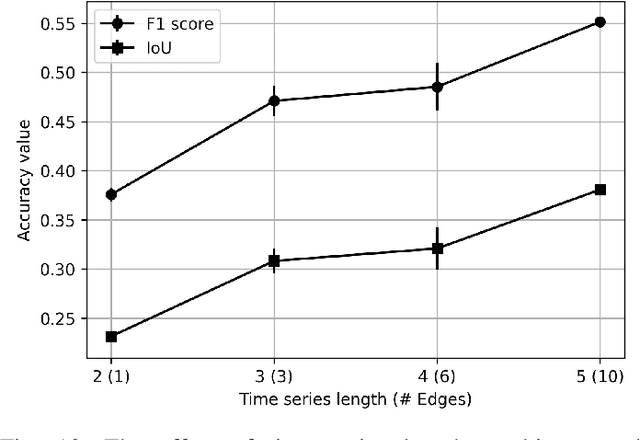
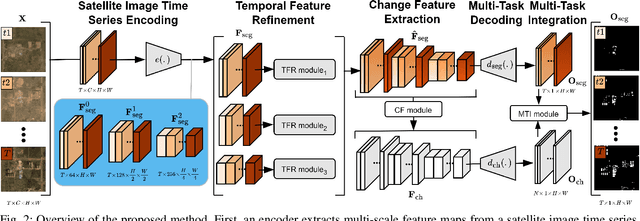

Abstract:Urbanization advances at unprecedented rates, resulting in negative effects on the environment and human well-being. Remote sensing has the potential to mitigate these effects by supporting sustainable development strategies with accurate information on urban growth. Deep learning-based methods have achieved promising urban change detection results from optical satellite image pairs using convolutional neural networks (ConvNets), transformers, and a multi-task learning setup. However, transformers have not been leveraged for urban change detection with multi-temporal data, i.e., >2 images, and multi-task learning methods lack integration approaches that combine change and segmentation outputs. To fill this research gap, we propose a continuous urban change detection method that identifies changes in each consecutive image pair of a satellite image time series. Specifically, we propose a temporal feature refinement (TFR) module that utilizes self-attention to improve ConvNet-based multi-temporal building representations. Furthermore, we propose a multi-task integration (MTI) module that utilizes Markov networks to find an optimal building map time series based on segmentation and dense change outputs. The proposed method effectively identifies urban changes based on high-resolution satellite image time series acquired by the PlanetScope constellation (F1 score 0.551) and Gaofen-2 (F1 score 0.440). Moreover, our experiments on two challenging datasets demonstrate the effectiveness of the proposed method compared to bi-temporal and multi-temporal urban change detection and segmentation methods.
Multi-Modal Deep Learning for Multi-Temporal Urban Mapping With a Partly Missing Optical Modality
Jun 01, 2023Abstract:This paper proposes a novel multi-temporal urban mapping approach using multi-modal satellite data from the Sentinel-1 Synthetic Aperture Radar (SAR) and Sentinel-2 MultiSpectral Instrument (MSI) missions. In particular, it focuses on the problem of a partly missing optical modality due to clouds. The proposed model utilizes two networks to extract features from each modality separately. In addition, a reconstruction network is utilized to approximate the optical features based on the SAR data in case of a missing optical modality. Our experiments on a multi-temporal urban mapping dataset with Sentinel-1 SAR and Sentinel-2 MSI data demonstrate that the proposed method outperforms a multi-modal approach that uses zero values as a replacement for missing optical data, as well as a uni-modal SAR-based approach. Therefore, the proposed method is effective in exploiting multi-modal data, if available, but it also retains its effectiveness in case the optical modality is missing.
Investigating Imbalances Between SAR and Optical Utilization for Multi-Modal Urban Mapping
Apr 11, 2023



Abstract:Accurate urban maps provide essential information to support sustainable urban development. Recent urban mapping methods use multi-modal deep neural networks to fuse Synthetic Aperture Radar (SAR) and optical data. However, multi-modal networks may rely on just one modality due to the greedy nature of learning. In turn, the imbalanced utilization of modalities can negatively affect the generalization ability of a network. In this paper, we investigate the utilization of SAR and optical data for urban mapping. To that end, a dual-branch network architecture using intermediate fusion modules to share information between the uni-modal branches is utilized. A cut-off mechanism in the fusion modules enables the stopping of information flow between the branches, which is used to estimate the network's dependence on SAR and optical data. While our experiments on the SEN12 Global Urban Mapping dataset show that good performance can be achieved with conventional SAR-optical data fusion (F1 score = 0.682 $\pm$ 0.014), we also observed a clear under-utilization of optical data. Therefore, future work is required to investigate whether a more balanced utilization of SAR and optical data can lead to performance improvements.
Mapping Urban Population Growth from Sentinel-2 MSI and Census Data Using Deep Learning: A Case Study in Kigali, Rwanda
Mar 15, 2023Abstract:To better understand current trends of urban population growth in Sub-Saharan Africa, high-quality spatiotemporal population estimates are necessary. While the joint use of remote sensing and deep learning has achieved promising results for population distribution estimation, most of the current work focuses on fine-scale spatial predictions derived from single date census, thereby neglecting temporal analyses. In this work, we focus on evaluating how deep learning change detection techniques can unravel temporal population dynamics at short intervals. Since Post-Classification Comparison (PCC) methods for change detection are known to propagate the error of the individual maps, we propose an end-to-end population growth mapping method. Specifically, a ResNet encoder, pretrained on a population mapping task with Sentinel-2 MSI data, was incorporated into a Siamese network. The Siamese network was trained at the census level to accurately predict population change. The effectiveness of the proposed method is demonstrated in Kigali, Rwanda, for the time period 2016-2020, using bi-temporal Sentinel-2 data. Compared to PCC, the Siamese network greatly reduced errors in population change predictions at the census level. These results show promise for future remote sensing-based population growth mapping endeavors.
Urban Change Detection Using a Dual-Task Siamese Network and Semi-Supervised Learning
Apr 26, 2022
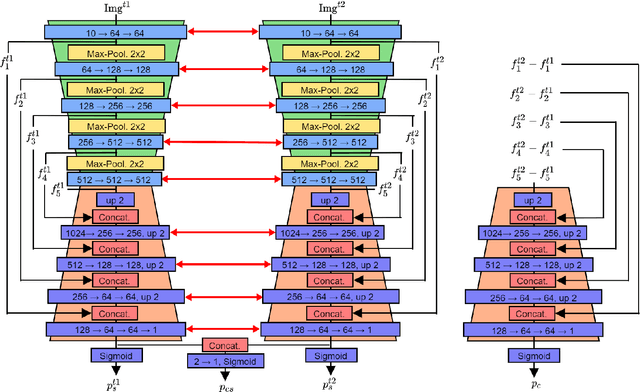
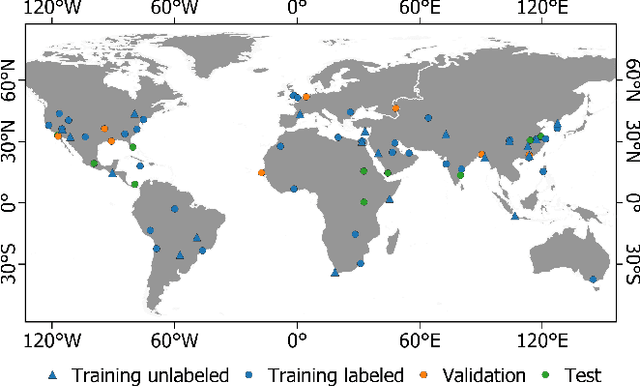
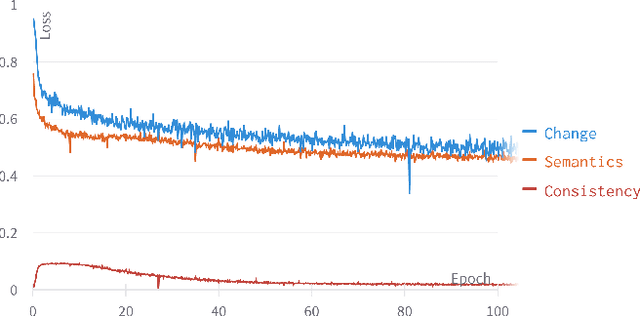
Abstract:In this study, a Semi-Supervised Learning (SSL) method for improving urban change detection from bi-temporal image pairs was presented. The proposed method adapted a Dual-Task Siamese Difference network that not only predicts changes with the difference decoder, but also segments buildings for both images with a semantics decoder. First, the architecture was modified to produce a second change prediction derived from the semantics predictions. Second, SSL was adopted to improve supervised change detection. For unlabeled data, we introduced a loss that encourages the network to predict consistent changes across the two change outputs. The proposed method was tested on urban change detection using the SpaceNet7 dataset. SSL achieved improved results compared to three fully supervised benchmarks.
 Add to Chrome
Add to Chrome Add to Firefox
Add to Firefox Add to Edge
Add to Edge